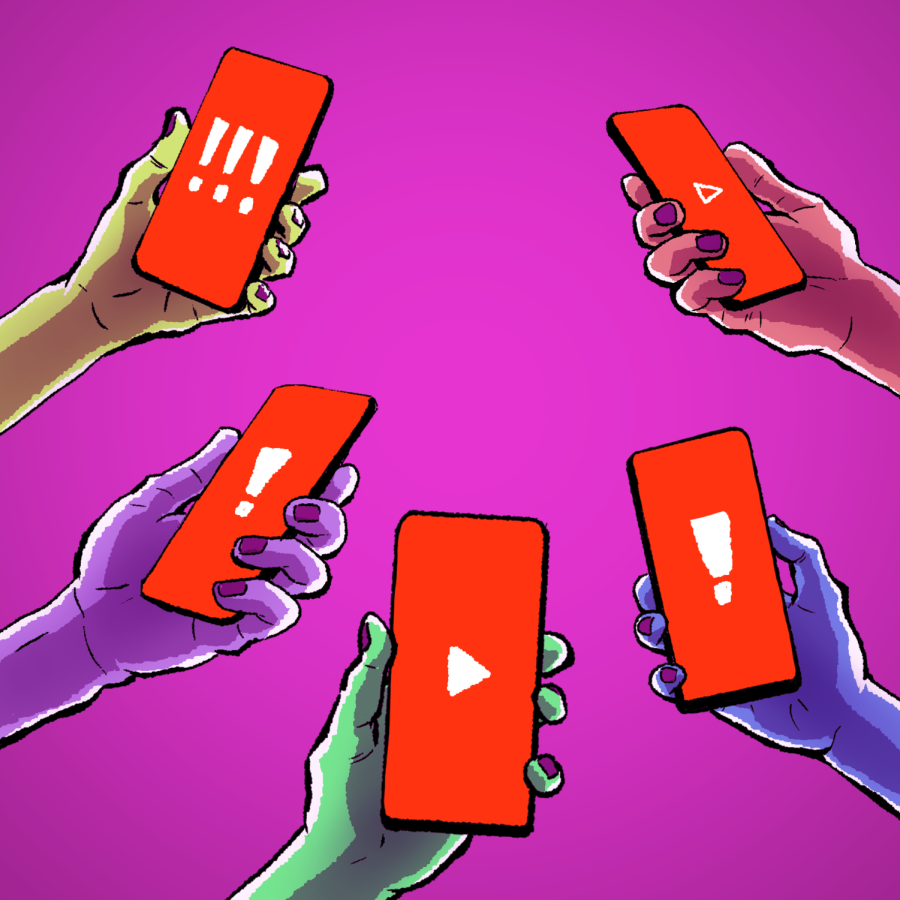Editorial: We cause pain by sharing graphic, violent videos
Multiple hands holding phones with play signs and exclamation marks. Social media users and platforms should be more considerate when sharing graphic content for other users to spread.
February 12, 2023
The recent social media trend of sharing graphic videos and content needs to end. It makes sense to share what has happened with the rest of the world because it will bring awareness and hold accountability, but it’s unnecessary to share such graphic, video violence.
If graphic content is shared online at all, platforms should work to ensure that content is not reposted without being reviewed. This would help avoid posts that recontextualize the events with the aim of spreading misinformation.
In the wake of the brutal attacks on Tyre Nichols and Paul Pelosi, social media users broaden the spread of videos of their attacks across social media platforms.
In instances where gruesome videos and pictures have gone viral, news organizations grapple with trying to do right by their viewers, whether that be by broadcasting or sharing the incident on their social media platforms.
Mark Whitaker, who served as the top editor of Newsweek magazine and as an executive for CNN and NBC News, spoke to The Washington Post about how news organizations deal with sharing violent and graphic content.
“News organizations ‘have to be extremely judicious in what you show,’ although he (Whitaker) acknowledged that the graphic nature of videos is often a big element of a story,” said The Washington Post, quoting Whitaker.
This idea of sharing graphic videos continues beyond news organizations. Social media apps and their individual users are primarily at fault.
Social media apps like Instagram and YouTube provide warnings when graphic content is posted or shared but do not outright ban it. Twitter rules show that users themselves have to identify when content is sensitive. Twitter does not actively post warnings or take down the content itself.
Without strict rules regarding graphic content, these apps allow users to spread content that might be harmful to those who have a sensitivity or are recovering from trauma.
“If you’re not judicious in thinking through the ethical challenges every time you air it (graphic videos) or every time you place it on a webpage, you run the risk of unwittingly exposing people who are already suffering from various types of trauma in their lives to images that are hard to digest,” Bruce Shapiro, executive director of the Dart Center for Journalism and Trauma, told The Washington Post.
Trauma may also be inflicted on the families that are affected by the crime. It can make them relive the situation over again or be reminded of what has happened to their loved ones.
“All of these ways of experiencing images like these when they spread out into the world are happening at once, right? Some people are activated by viewing them. Some people are further traumatized by viewing them. And some people derive some kind of, you know, sick fascination and enjoyment out of viewing them. And so sharing them in order to shock people’s consciences means also necessarily doing these other things that you might not want to do,” Tara Pixley, a photojournalist and a professor at Loyola Marymount University, told NPR’s Gene Denby.
If graphic content is posted on any platform, individuals should not share it “widespread” like the videos of George Floyd, Paul Pelosi, Trayvon Martin and Tyre Nichols. Social media platforms need to work on finding ways to review user posts and prevent future spread of graphic content like has been in the past.
Those who use any social media platform, whether it be Facebook, Twitter or Snapchat, need to remember that their followers are also human, not a robot, behind a screen. Be considerate to those who you share content with.







